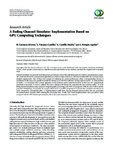| dc.contributor.author | CARRASCO ALVAREZ, ROBERTO | |
| dc.contributor.author | Vazquez Castillo, Javier | |
| dc.contributor.author | Castillo Atoche, A. | |
| dc.contributor.author | ORTEGON AGUILAR, JAIME SILVERIO | |
| dc.date.accessioned | 2018-09-14T22:00:13Z |
| dc.date.available | 2018-09-14T22:00:13Z |
| dc.date.issued | 2015 |
| dc.identifier.uri | http://hdl.handle.net/20.500.12249/1407 |
| dc.description.abstract | "Channel simulators are powerful tools that permit performance tests of the individual parts of a wireless communication system. This is relevant when new communication algorithms are tested, because it allows us to determine if they fulfill the communications standard requirements. One of these tests consists of evaluating the system performance when a communication channel is considered. In this sense, it is possible to model the channel as an FIR filter with time-varying random coefficients. If the number of coefficients is increased, then a better approach to real scenarios can be achieved; however, in that case, the computational complexity is increased. In order to address this issue, a design methodology for computing the time-varying coefficients of the fading channel simulators using consumer-designed graphic processing units (GPUs) is proposed. With the use of GPUs and the proposed methodology, it is possible for nonspecialized users in parallel computing to accelerate their simulation developments when compared to conventional software. Implementation results show that the proposed approach allows the easy generation of communication channels while reducing the processing time. Finally, GPU-based implementation takes precedence when compared with the CPU-based implementation, due to the scattered nature of the channel." |
| dc.description.provenance | Submitted by Yaremi Isabel Can Chulin (1315421@uqroo.mx) on 2018-09-14T22:00:13Z
No. of bitstreams: 1
CarrascoAlvarez-R_A-fading-channel-simulator-implementation-based-on-GPU-computing-techniquesOpen-Access_2015.pdf: 3210679 bytes, checksum: 93293152ccc253ef44a20080003dc505 (MD5) |
| dc.description.provenance | Made available in DSpace on 2018-09-14T22:00:13Z (GMT). No. of bitstreams: 1
CarrascoAlvarez-R_A-fading-channel-simulator-implementation-based-on-GPU-computing-techniquesOpen-Access_2015.pdf: 3210679 bytes, checksum: 93293152ccc253ef44a20080003dc505 (MD5)
Previous issue date: 2015 |
| dc.format | pdf |
| dc.language.iso | eng |
| dc.publisher | Hindawi Publishing Corporation |
| dc.relation | 10.1155/2015/237061 |
| dc.rights.uri | http://creativecommons.org/licenses/by-nc-nd/4.0 |
| dc.source | Mathematical Problems in Engineering |
| dc.subject | Communication System |
| dc.subject | Channel Simulation |
| dc.subject | GPU Implementation |
| dc.subject.classification | INGENIERÍA Y TECNOLOGÍA |
| dc.title | A fading channel simulator implementation based on GPU computing techniques. |
| dc.type | Articulo |
| dc.type.conacyt | article |
| dc.rights.acces | openAccess |
| dc.identificator | 7 |
| dc.audience | generalPublic |
| dc.identifier.doi | 10.1155/2015/237061 |
| dc.division | Biblioteca Unidad Académica Chetumal, Santiago Pacheco Cruz |





